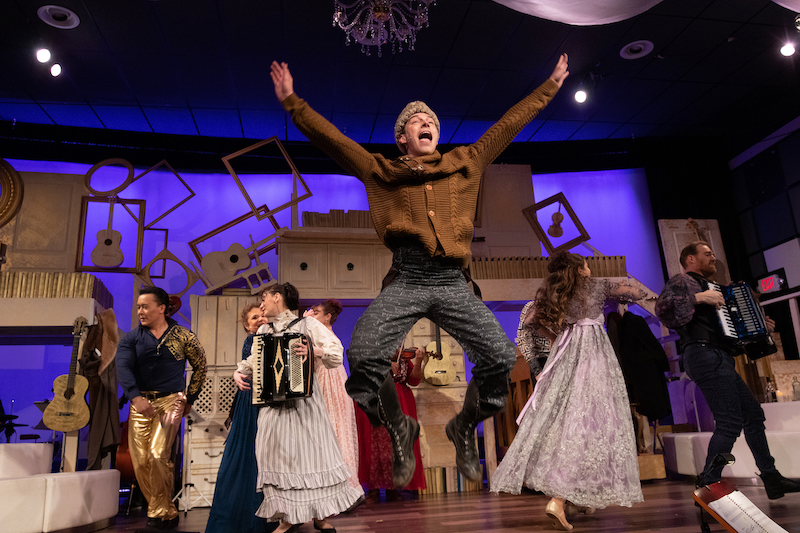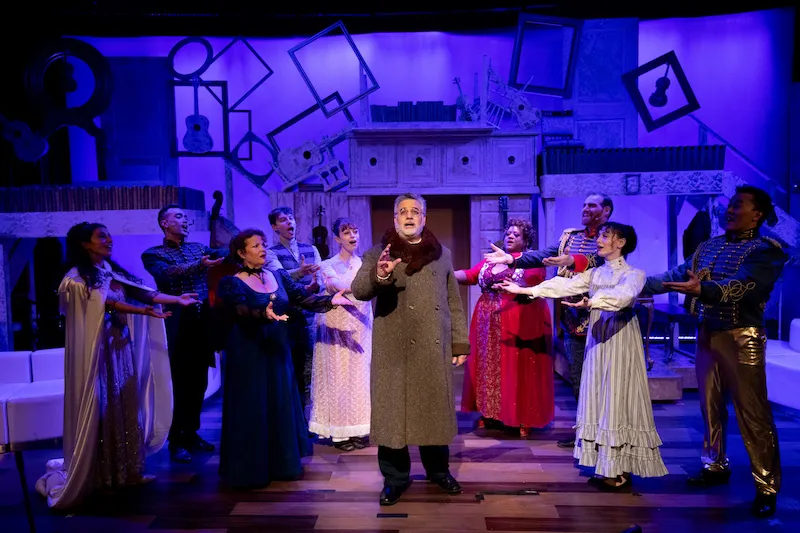“Natasha, Pierre, and the Great Comet of 1812,” written by Dave Malloy, has always been one of my favorite musical theater shows. The piece takes a 70-page sliver of “War and Peace” by Leo Tolstoy and twists it into a two-hour tale of Russian aristocracy and marriage, joy and chaos. It delivers it all with ballads and pop-opera songs that make you bounce in your seat.
Seeing the show in San Jose was like revisiting an old friend: through effective staging, choreography and overall energy that poured out of each cast member, I walked out with a greater understanding and appreciation for something I have loved for years.
Set in the midst of the Napoleonic wars, it follows Pierre (Stephen Guggenheim) — an old man in the depths of existential crisis — and Natasha (Paloma Aisenberg ’23) — a naive-yet-beautiful young girl longing for her away-at-war fiancé Andrey (F. James Raasch). When Natasha arrives in Moscow with her cousin Sonya (Annie Hunt) to stay with godmother Marya (Susan Gundunas), she has to navigate society while remaining faithful to her engagement. Everything changes when she meets the charming player Anatole (Jared Lee), leading to a clash of emotions, a scandalous affair and a (ruined) elopement scheme.
From the onset, I noticed that the show efficiently used the theater’s small space. Numbers made use of the aisle space and there was a T-shaped part of the stage that extended into the audience, creating intimacy within the theater. The remarkable set design (by Jon Gourdoine) included several levels and moving furniture pieces. While simple in appearance, they were crucial to show the different locations the characters inhabited, ranging from a club to a family home.
My favorite part of the set were the floating instruments scattered throughout the stage. Actors would play instruments during the show, such as Pierre on the piano, Andrey on the accordion and Hélène (Juanita Harris) on the violin.
This instrument motif reflected the meta aspect of “The Great Comet”: the characters are performing this as if it were a book. Not only were the lyrics often delivered from the third-person, but often if characters were not in a song, they would observe from different parts of the stage — emulating someone passively reading a book — or fill in as extra characters outside of their roles.
At first, I questioned if the small cast would successfully capture the world of the show without a full ensemble, which the original production had. By the end, though, it was obvious that question didn’t need to be asked.

With influences from pop, rock and a blend of Russian folk, upbeat musical numbers consisted of intricate choreography that replicated the lively energy of the society. Standouts were “The Club,” where a line of people encouraged Pierre to indulge in his alcoholism; “Balaga,” which introduced the crazed troika driver portrayed by Corey Bryant; and “The Abduction,” where Anatole, Dolokhov (Nicholos Rodrigues) and Balaga arranged in a triangular formation to emulate a vehicle traveling through Moscow.
The show is known for an immersive experience with plenty of audience interaction, and this cast managed to regularly acknowledge the presence of an audience without breaking character. Some audience members would become characters themselves. Some characters, such as Old Prince Bolkonsky and Anatole, directly flirted with or yelled at audience members. My favorite audience interaction was when they handed me a shot glass (full of water, of course) during “Prologue,” which was in line with the alcohol and drinking shown thematically throughout the show.
Every actor was brilliantly casted with equally outstanding vocals to back them up. Aisenberg stood out as Natasha; she was quite literally glowing every time she walked on stage. Her solo, “No One Else,” showcased her soprano range and grasp on clarity as she sang about missing her fiancé after the failed dinner with his family.
Sonya is first introduced with the phrase “Sonya is good”, and Hunt portrayed that kindness to perfection. This was the first time “Sonya Alone” — a song where Sonya dedicates herself to protecting Natasha no matter what though she disapproves of Anatole — made me tear up.
Even Mary (Osher Fine), labeled a “minor character” in the first song, stood out in the way she held herself on stage. Her hunched shoulders and fearful gaze during “The Private and Intimate Life” showed how caged she was by her father.
The casting of Anatole was equally crucial to this production’s success. Lee is older than other versions of the character that I’ve seen, which accurately reflects his age in the source material. While Lee plays an equally handsome and charismatic character, it felt how it should have felt — predatory, given that Natasha is in her early 20s at most. It left no room for romanticization of their relationship.
Lee did an excellent job at portraying a walking red flag, his first entrance showcasing an egotistical swagger that indicated why the song about Anatole and Natasha’s elopement was called “The Abduction.” This power dynamic made the show realistic: Natasha later takes responsibility for cheating, but her naivety leaves room for forgiveness as Anatole is not an honest man.
Other elements of production design — sound, lighting and costumes — were incredible, too. There was little to no feedback with the microphones and I heard every word, which is important as the entire musical is sung-through. Lighting effectively captured the mood of each song, and an arrangement of chandeliers and string-lights on the ceiling made it so that the final song — “The Great Comet of 1812” — had a fixture resembling a comet. Costumes were well-planned and versatile as cast members played multiple characters and characters had to change outfits in between or during songs.
My only complaint was that I didn’t like Anatole’s gold pants. While he is a flashy character, something more sleek and classic would have blended in better with the other costumes and not looked too on-the-nose. Even if he needed to stand out, a deep red coat or more promiscuous shirt could have accomplished this while remaining in line with the show’s aesthetic.
Two hours of Russian literature live doesn’t necessarily sound appealing at the first glance; however, audience members left in awe, muttering their admiration as they exited the theater. I affirm that this production is a must see for Bay Area theater-goers — go, follow the comet.
Editor’s Note: This article is a review and includes subjective thoughts, opinions and critiques.
